This is a Review of Oppo HA-2 portable headphone amplifier and DAC with USB OTG support. http://www.oppodigital.com/headphone-amplifier-ha-2/
I have been preaching in a number of my portable amplifier reviews that many people get these amps for a wrong reason. Instead of using them with high impedance cans (or earbuds), or driving low sensitivity and less efficient headphones, or applying them to extend battery life of your source (lowering source volume while boosting amp) – people want their portable audio setup to look cool with a small amplifier strapped to the back of a DAP or a smartphone. When it comes to Oppo latest HA-2 portable amp – forget about anything I said, and just look for any excuse to use this slick little audio gadget!!!
In my recently published PM-3 review, I referred to these latest Oppo products as a “dynamic duo” because their synergy is fantastic. But it would be a one-trick-pony to use only for that functionality. When you look at HA-2 spec, you can see it’s not only a portable headphone amplifier, but also a high quality ESS Sabre Reference DAC compatible with PCs and MACs, and USB OTG DAC compatible with Android phones, as well as iOS. Plus, in addition to having a high capacity battery for its own internal power up, it can be used as external battery charger for your smartphone. The list of features and technical spec behind it is very impressive, but just like with PM-3 – design details overshadow everything. Now, before anybody jumps into conclusion that I’m shallow when it comes to audio gear, let me go into a more detailed write-up to describe the brains behind this beauty.
Unlike a formally dressed gift box packaging found with PM-3, here Oppo changed its strategy with an eye popping 3D artwork on the front and the side. You also get bold highlights of all the main features, a very detailed spec, and what appears to be a quick start guide describing every port and every supported connection. The “gift box” is still there, but now it’s wrapped in a packaging sleeve with all this info on the cover. I think the idea of such quick-start guide is really interesting where you don’t have to go digging for manuals and can just look it up fast by flipping over the packaging box.
Once the box is out of the sleeve and the cover it off, you can see a tray with leather wrapped HA-2 and a brushed aluminum top with a volume pot. Underneath of this tray you will find documentation and the wall charger with another flap under documentation to reveal included cables. This particular unboxing experience is nothing short of unpacking a… smartphone! You get a smartphone shaped super-slim HA-2, a wall charger and cables – no surprises here since Oppo is also behind a lineup of popular smartphones.
Unboxing.
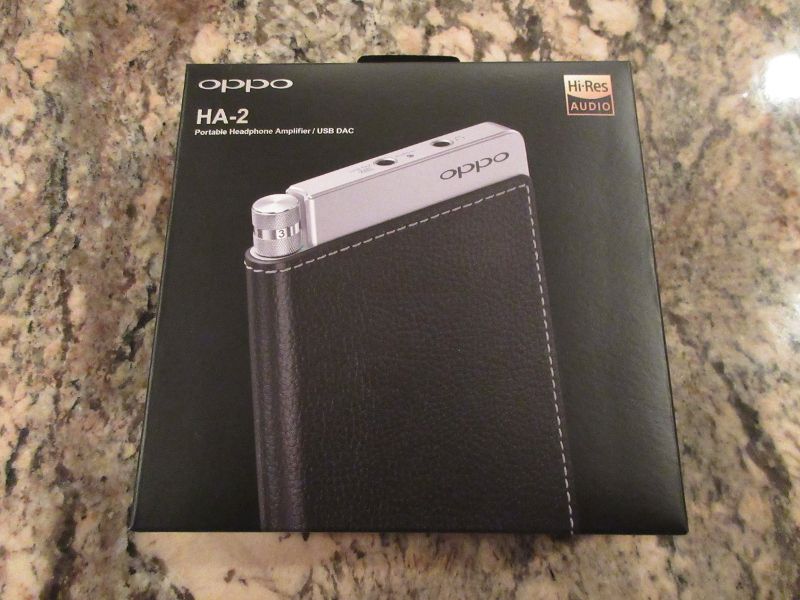
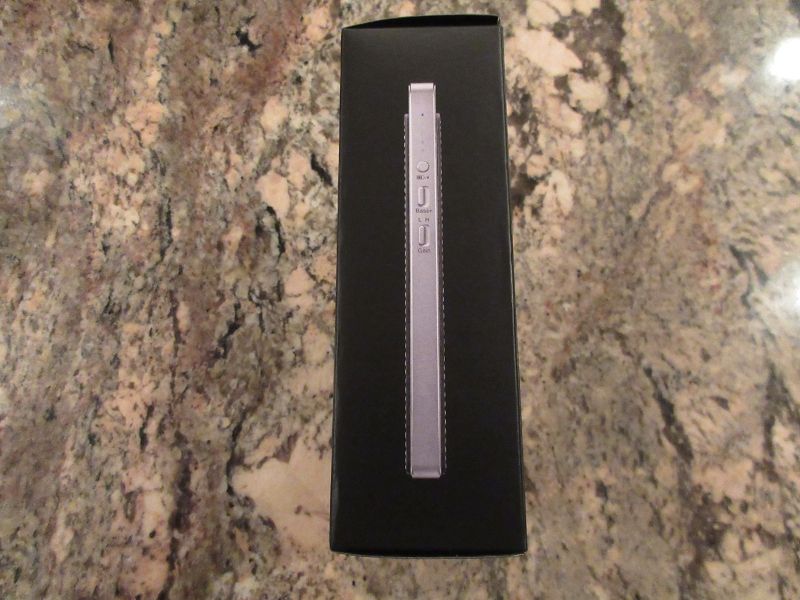
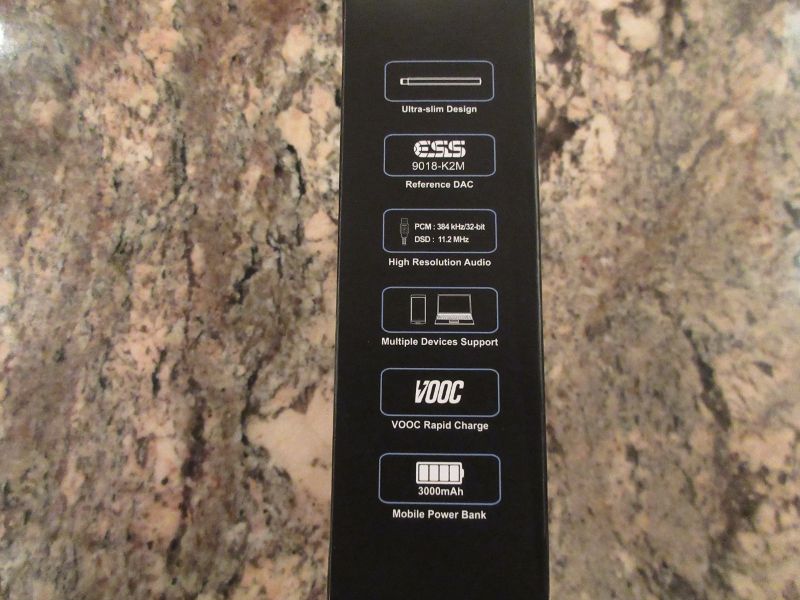


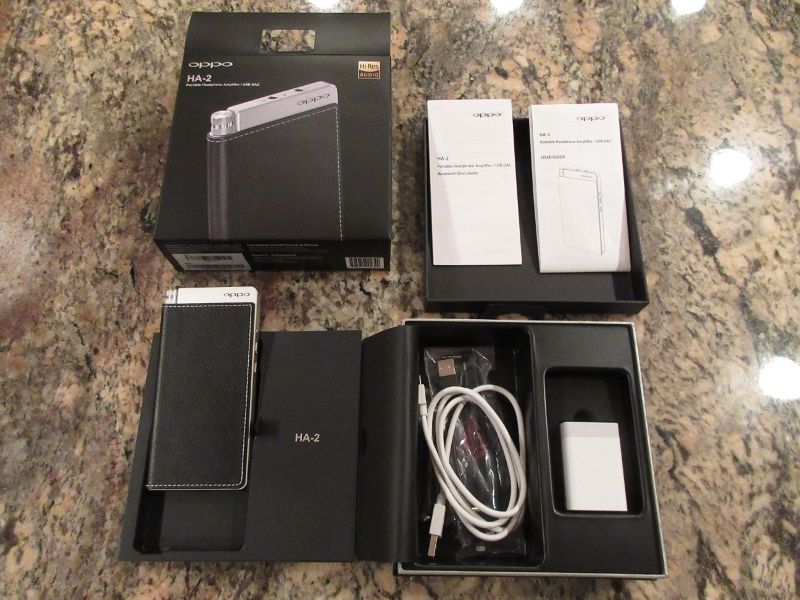
Looking closer into the included accessories you will find a wall charger with a heavy duty premium (low gauge wire) cable, a short LO 3.5mm to 3.5mm audio interconnect for an analog audio input from a source, a digital micro-usb to micro-usb OTG short cable for a direct connection to Android phones, a full size usb to lightning connection for iPhone/iPad, and a pair of rubber bands to strap HA-2 to your source. USB OTG cable is great and very convenient to use without a need for OTG adapters, but I wish they would include one with right angle connectors. Just think about it, usb connection is at the bottom while HO is at the top, so when smartphone/HA-2 stack is in your pocket it will be sitting on the cable/connector. Though right angle usb otg cables are available on eBay (just ordered one now), I wish Oppo would offer a shorter version of their own which I’m sure will be a higher quality. Since I have Apple-free household, I didn’t test lightning cable but aware this one doesn’t require a camera kit.
So how about that wall charger and a stiff usb cable? This is a great example of tech collaboration under Oppo umbrella. VOOC rapid charge technology was already introduced in Oppo smartphones where it’s backward compatible to source a typical 5V @2A power or accelerated charging with 5V @5A in devices that support it. Though the industry standard now is leaning more toward Qualcomm QC2.0 for rapid smartphone charging where output voltage switches to 9V or 12V depending on the device, Oppo is pushing their own standard. VOOC rapid charger cuts down time significantly where HA-2 3000 mAh battery gets charged fully in 90min, but HA-2 is still backward compatible to use with any smartphone 5V/2A charger. To support high current, HA-2 usb cable uses low gauge thicker wire and a custom crafted micro-usb connector. The only negative here is once you get spoiled by its fast charging and if something breaks, you have to buy genuine Oppo replacement, since I wouldn’t trust anything else from ebay. But like I said, it’s not a showstopper because it’s backward compatible with any standard charger.
Accessories.
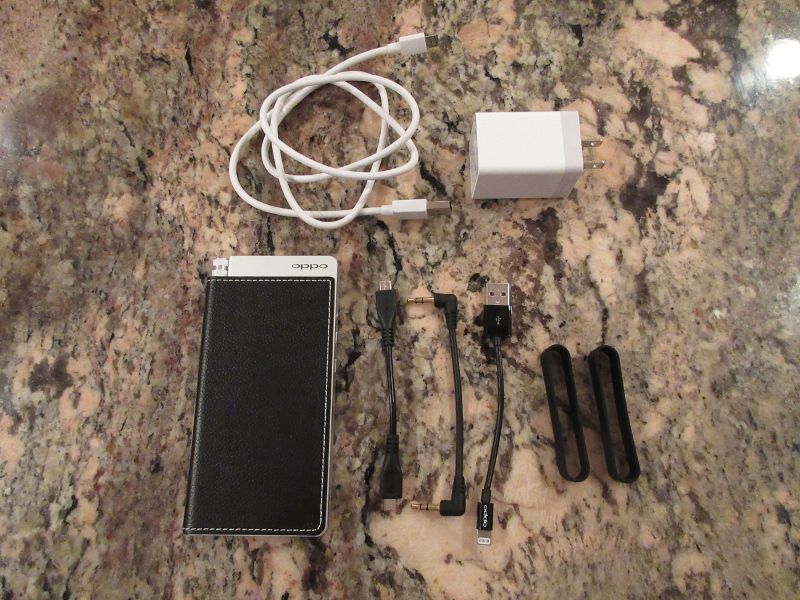
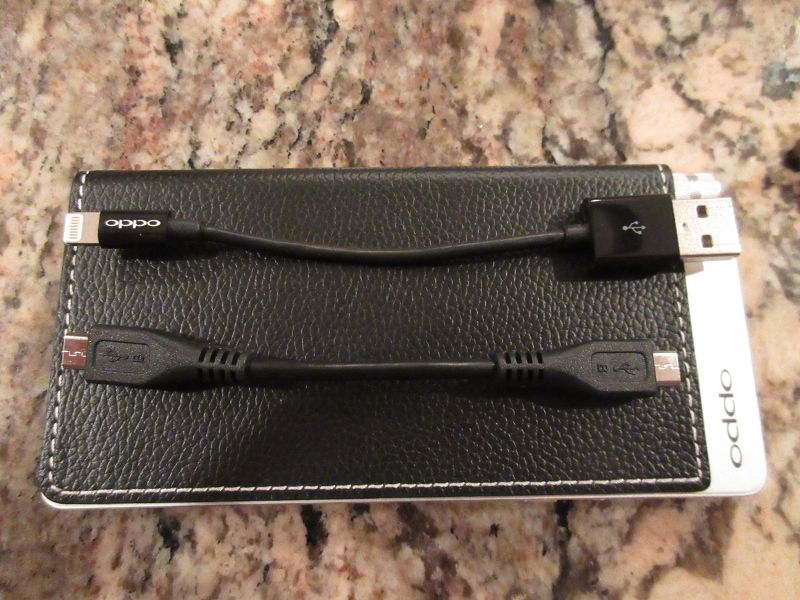
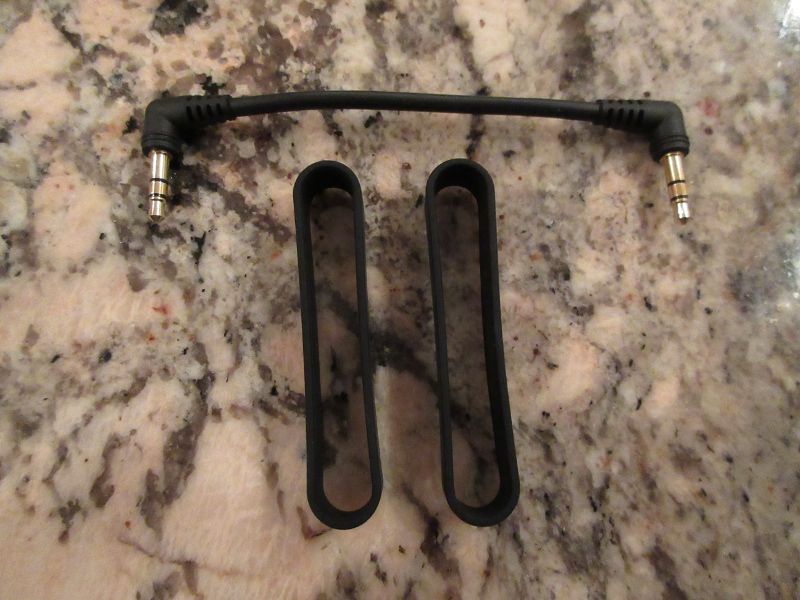
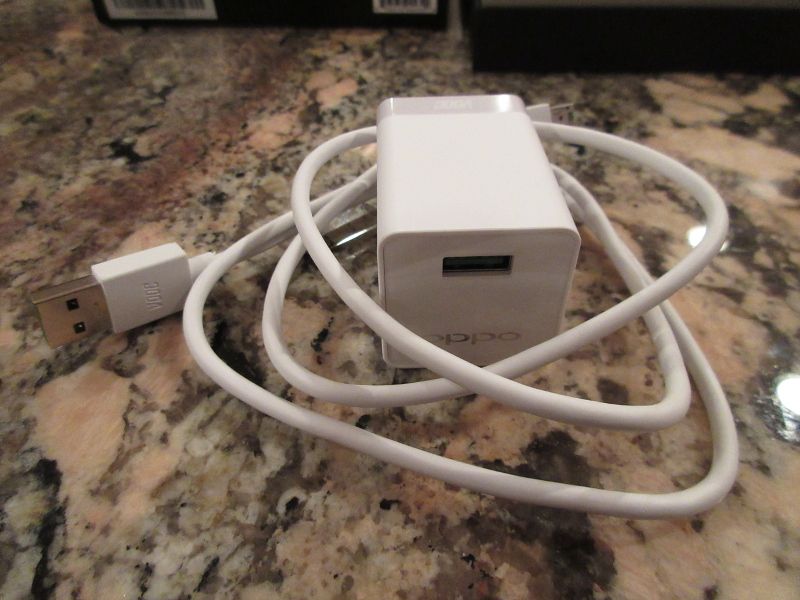

Moving on to a design, I can’t help but to continue using “smartphone” reference in HA-2 description, undeniably with iPhone inspiration. With dimensions of 68 x 137 x 12 mm and at 175g this is definitely in a territory of slim smartphone footprint. The first thing you notice when looking at HA-2 is the leather-wrapped exterior with a neat white stitching around it. Obviously, the leather material is not stitched to a metal, but it creates a premium effect and a feeling of an expensive gear in your hand. You probably going to call me crazy, but I have mixed feelings about the leather. It looks like a million bucks in standalone application, and you don’t have to worry about your DAP rubbing against HA-2 surface, but it also means that you can’t apply Velcro to the back or to apply re-usable 3M double-sided sticky strips. I love the look of HA-2 wrapped in leather, but a part of me wants to feel an even thinner and lighter all brushed aluminum surface of this amp/DAC.
Leather wrap aside, all the controls occupy the top, the bottom, and one open side of this device. At the top you have a shared Line Out and Audio In 3.5mm port, and Headphone Out 3.5mm port. Everything is clearly labeled and has a letter code next to the port (more about it later). In the corner recessed you will find an analog volume potentiometer with a nice turn resistance preventing from accidental volume bump, while still allowing turning it with a swipe of a thumb. As you twist to turn it on, you are greeted with a soft green led light to indicate the power on and to give you some visual of the level in the dark. This knob is part of a dual volume control where the volume in ESS Sabra DAC gets mapped to a digital volume of your device and you can further adjust it with a pot to give you more control.
On a side you have H/L Gain switch, where High gain is capable of driving 300mW into 16 ohm load, while switching to Low gain will be more appropriate for sensitive IEMs. Between gain setting and dual volume control, you have a lot of flexibility to drive nearly every type of headphones. Before I go any further, I have to talk about one feature which I haven't seen anywhere else. Gain switch has a volume mute/fade-in functionality which is simply BRILLIANT!!! How many times have you switched from low to high gain while forgetting to turn down the volume? Here after the switch you get a short sound mute followed by a fade in effect to slightly delay a full blast of high gain power - just enough to give you a few seconds to react by either turning the volume down or ripping those headphones off your head. Hard to imagine nobody else thought of something like this before.
Above gain control you have Bass boost which affects both sub-bass and miss-bass frequencies. This worked great with EL-8C headphones to warm up their sound, but was a bit overwhelming with PM-3, unless you are a certified basshead. Either way, it’s an option to experiment with different headphones. Even so I’m fully Android vested, I do know these Gain and Bass boost sliding switches have a lot of resemblance with iPhone volume/mute button. Above the switches you have a power check button which triggers 4 green led segments (in 25% increments) to show the battery health. If you press and hold it down, it will trigger to lit up the fifth blue led to start charging externally connected device. Battery life is quite impressive with 12+ hours of use as analog amp and almost 7 hours of use as a digital DAC/amp.
The bottom of the device has full size usb port labeled with “A” (for Apple) where you attach cable with lightning connector tip to pair up with your iOS devices, and micro-usb port with “B” label for USB OTG cable for your Android phone pair up or connection to PC/MAC for use as USB DAC. For the reference, Audio In on the top had “C” label, while Line Out has A/B label indicating DAC output from either your smartphone or computer digital audio sources. All this ties up to A/B/C switch located at the bottom which selects functionality and input/output of HA-2. If you want to connect to Apple device, switch to A and connect corresponding cable to A-port. If you want Android or USB DAC functionality – switch it to B-port. If you want a straight analog in/out amplifier – switch it to C. It takes a few minutes to get used to it, and afterwards it becomes second nature.
I just wish there would be an implementation of transport control buttons to Play/Pause and Skip, similar to A200p or E18.
Design.

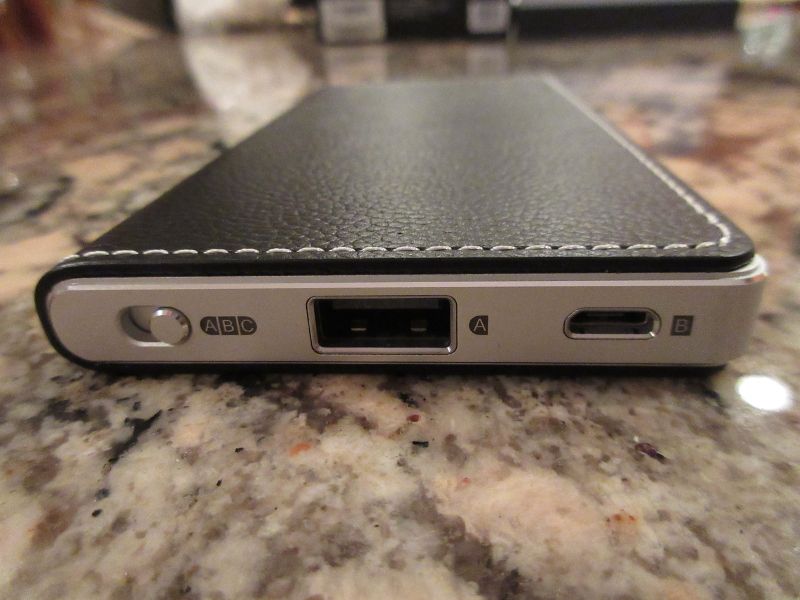
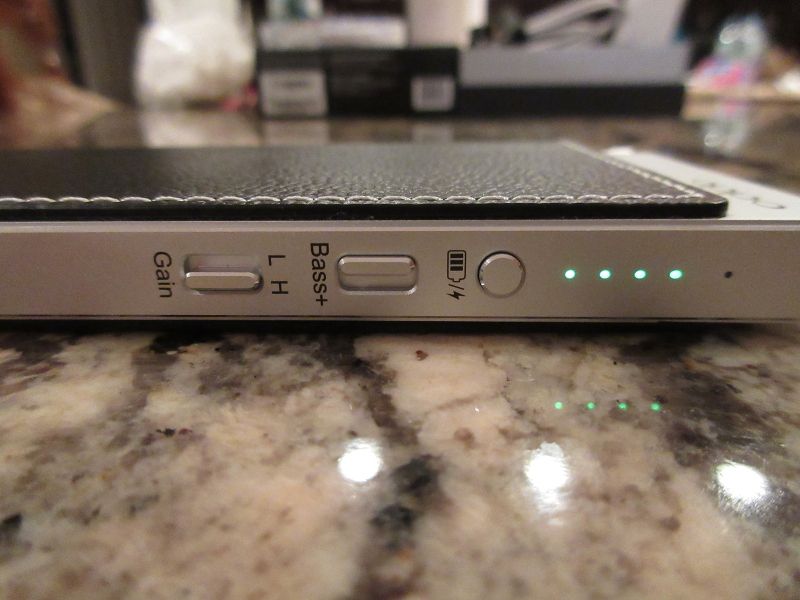

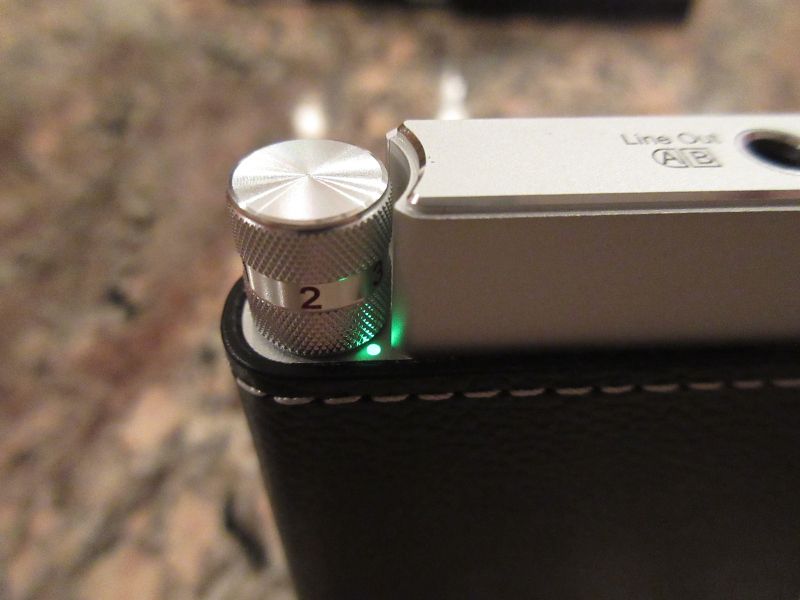
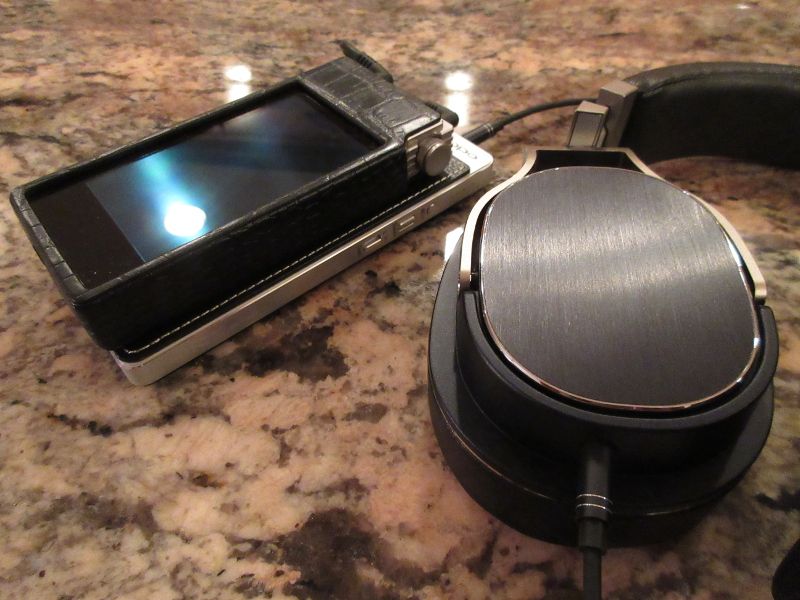
Once I got familiar with all the ports, controls, switches, I couldn’t wait to pair it up with my Galaxy Note 4. There is no need for any USB OTG adapter to connect to your smartphone; using the included short micro-usb to micro-usb cable is all that needed to connect HA-2. I assume the cable already has internally shorted (pin 4 to pin 5) connection to enable OTG host interface on your phone. As I mentioned before, my only wish here is to have right angle connectors to avoid arching of the cable and making it more uncomfortable when placing in your pocket. Other than that, everything worked flawlessly and I had a dual volume control to adjust from my phone and from HA-2 volume knob.
While you can drive PM-3 from my Galaxy Note 4, there is not enough power to drive it with authority to bring Oppo planar magnetic headphones sound to their full potential. Paired up with HA-2, I found bass to sound more articulate, tighter, especially mid-bass being faster and punchier. Mids sound improved with more clarity and better retrieval of details, and I also noticed an improvement in treble extension with more airiness in sound. Direct connection of PM-3 to Note 4 is convenient since I don’t need to carry an external DAC/amp, but once you hear how much better PM-3 sounds with HA-2 – there is no going back.
Keep in mind, while paired up with your smartphone, HA-2 should be drawing its power from the internal battery rather than your phone. And if your phone is running low on juice you can use HA-2 to charge it up. Just attach full size USB to port A while selecting A-port switch, and hold'n'press Power check button until blue led light turns on - now you are ready to charge your phone!
Smartphone pair-up/charging.
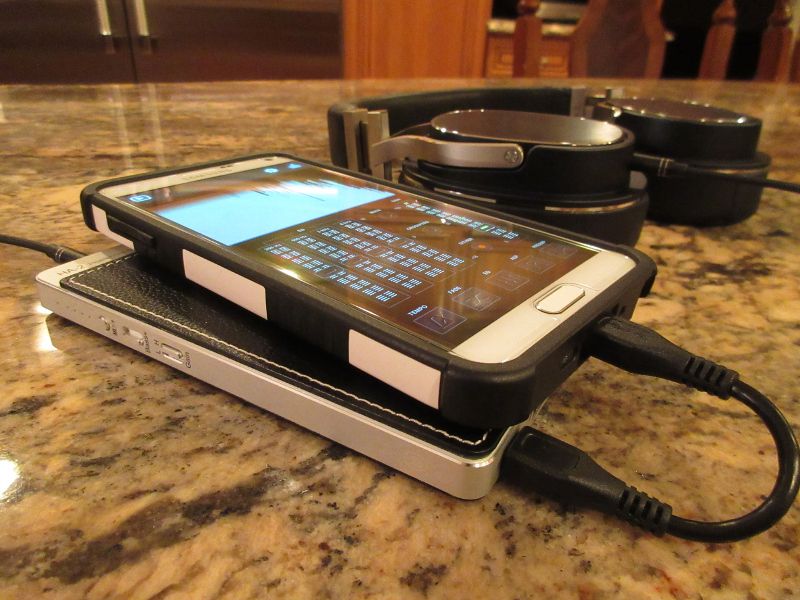
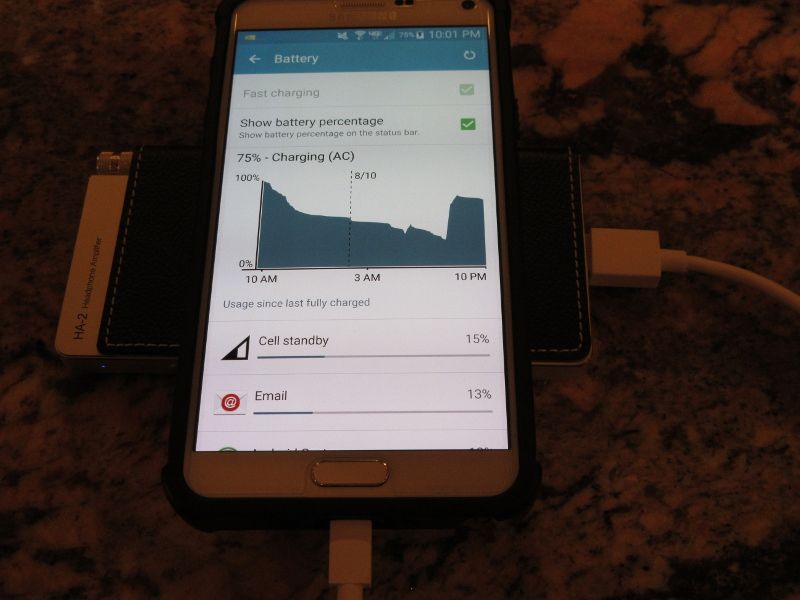
In addition to pair up with a smartphone, HA-2 can also be used as an external usb audio interface with your laptop/PC/MAC. To get it recognized, you do need to install drivers for your machine by visiting and following directions in: http://oppodigital.com/headphone-amplifier-ha-2/headphone-amplifier-HA-2-Support.aspx - keep in mind, only Windows users need to install the driver, while no driver is required to use with MAC and obviously no additional driver requires for iOS or Android. Once drivers are installed, HA-2 was recognized right away BUT it only worked from USB2.0 port of my ThinkPad T430s w/Win7, USB3.0 port wasn’t recognized. I found this limitation with a few other usb DACs I tested in the past, so just want others to be aware of it.
With a digital input, from either your computer USB port or smartphone micro-usb port, sound is being processed through a mobile version of ESS Sabre 32bit Reference ES9018-K2M DAC. This particular DAC is advanced enough to support PCM sampling frequencies of 44.1 kHz to 384 kHz, with a bit depth of 16/24/32-bits, and also DSD sampling frequencies of 2.8224 MHz (DSD64), 5.6448 MHz (DSD128), 11.2896 MHz (DSD256, native mode only). For some people spec numbers don’t mean much and you just care about end results, but in general a support of all these sampling frequencies up to a high level of lossless format means that a sound is not going to be internally down-sampled, keeping the original bit depth resolution and bandwidth of frequency content.
Paired up with my laptop and tested with PM-3, the sound quality improved significantly in comparison to stock HO and built-in audio chip. I experienced a smooth detailed tight sound with an improved dynamics, and also enjoyed the benefit of external volume control accessible right from HA-2. In comparison, GeekOut 450 offered a deeper bass extension, more mid-bass punch, slightly less details in mids, and less treble extension (noticeable in slightly reduced airiness). I was actually a bit surprised that sound quality of GO450 in comparison to HA-2 was a bit less refined and even a touch more veiled when connected to my laptop. With DragonFly, low end was also a bit elevated, while mids came closer to the level of detail retrieval though a bit darker. Actually, DF pair up with my laptop and PM-3 was not bad at all, just smoother and warmer in comparison to HA-2. Last but not least, pair up with FULLA made mid-bass a little more punchier, mids a little darker and smoother, and a little less detailed. Now keep in mind, all of these USB DACs are among my favorites, and comments above are just to describe a relative difference.
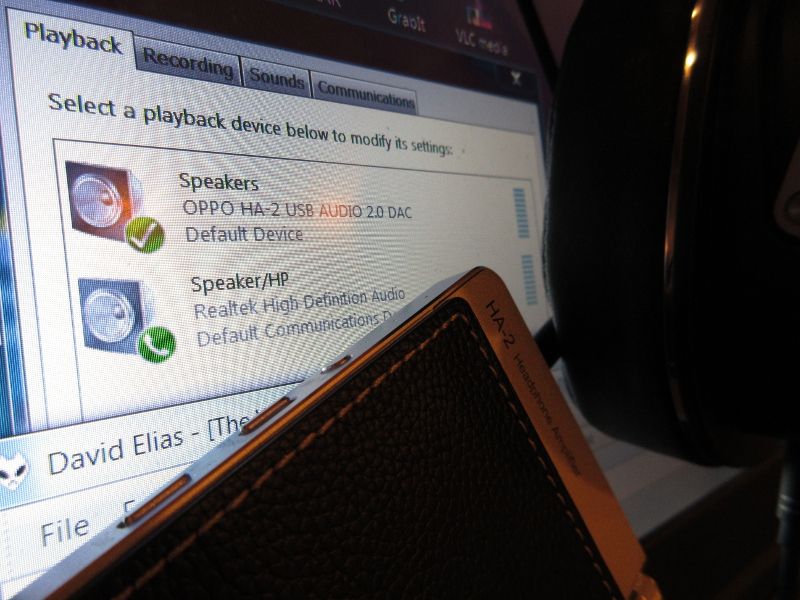
Since I already jumped into sound analysis with my comparison above between different USB DACs and with laptop and smartphone, let me step back and talk more about HA-2 sound quality based on its amplifier section without DAC in the loop (audio input driven from Line Out of my DAPs). The spec of HA-2 is very impressive with 1 Vrms audio-in and line-out, low HO output impedance of only 0.5 ohms, and being able to drive headphones up to 300 ohms. Also, output power (per max high gain setting) scales down from 300 mW @ 16 ohm to 220 mW @ 32 ohm and 30 mW @ 300 ohm which was still enough to drive 470 ohm R70x with authority.
In my testing I was using Cayin N6 as a Line Out source and noticed a common thread with different headphones where HA-2 was making sound smoother without any added coloration, just smooth and transparent with a noticeable improvement of detail retrieval. A soundstage width and depth wasn’t significantly affected, just remained average and similar to a source. Also, I wouldn’t call HA-2 having a perfect 100% black background, and I did hear a little bit of hissing with some of my sensitive IEMs.
In my personal experience it’s usually not easy to describe amplifier sound because it’s a function of headphones sound sig and a source driving it. Instead, it makes sense to describe it in a comparison to other amplifiers using the same source and headphone reference. That’s what I would like to do in my description below using N6 as a source and comparing HO vs pair up with Cayin C5 amp, FiiO E12A amp, and HA-2.
With PM-3:
- N6: has less aggressive bass, a bit smoother, clear/detailed mids, treble is moderately extended (thought with some roll off), not as airy.
- N6/C5: excellent pair up, deep articulate bass, more clarity/details in mids, a little more airiness in treble, soundstage gets more 3D with improved width/depth, and also improvement in separation and imaging.
- N6/E12A: very similar improvement as with C5 (more articulate bass, more clarity and better retrieval of details), but soundstage is not as wide/deep as C5.
- N6/HA-2: bass doesn't get deeper, but becomes tighter and more articulate with a better definition. Mids are more detailed but still remain smooth; treble extension improves and becomes a touch more airy. This is a perfect example of transparent sound improvement without changing the original sound and still showing a step up in detail retrieval.
With EL-8C:
- N6: bright mid-forward revealing sound, tight punchy bass without too much slam, bright detailed mids with a touch of metallic sheen, great crunchy airy treble.
- N6/C5: improved sub-bass extension, more punch in the mid-bass, detailed bright thinner mids, more pronounced mid-forward signature, and improved 3D staging.
- N6/E12A: same improvement as C5 minus soundstage expansion.
- N6/HA-2: bass is still tight and punchy and a little smoother, no longer sensing a metallic sheen in upper mids, definitely adds smoothness without taking away details. A bass boost adds more body to a sound, making it more balanced.
I found HA-2 to pair up very nicely with planar magnetic headphones, but it worked well with some other headphones in my collection.
ATH-R70x - smooth detailed transparent sound, drives these 470 ohm open back cans with an authority and I didn’t even have to switch HA-2 to a high gain.
ATH-MSR7 - tightens up the low end, makes upper mids smoother, sound is still detailed but a touch less harsh, a typical HA-2 improvement in making headphones sound smoother.
A83 - improves bass extension, and smoothes out upper mids without losing retrieval of details.
W60/UMPro50 - tightens the bass and improves retrieval of details in upper mids, while sound remains Westone-smooth.
Conclusion.
When it comes to HA-2, I was serious when I said you will be looking for any excuse to use this portable DAC/amp even on occasions when you don’t need an amp! HA-2 offers a unique combination of a fine crafted design with a high quality build, excellent ergonomics of controls including cleverly placed volume pot, and swiss-army knife functionality to use it as USB DAC connected to your PC/MAC or paired up with your iOS/Android phone or used as an external DAC (with Line Out output) or analog standalone portable amplifier. If that is not enough, you can use it as an external battery to charge your smartphone. And to top it all, it actually sounds very good with a smooth transparent detailed signature and plenty of juice to drive even some of the most demanding headphones. One might argue that often people use external amplifier to color/change a sound, and in that regard I found HA-2 to be on a safe side offering more subtle change. Maybe HA-2 is not the best sounding DAC/amp I ever heard (though definitely in the top), but I can safely say it’s the most versatile and the best looking portable DAC/amp I have tested to date.
I have been preaching in a number of my portable amplifier reviews that many people get these amps for a wrong reason. Instead of using them with high impedance cans (or earbuds), or driving low sensitivity and less efficient headphones, or applying them to extend battery life of your source (lowering source volume while boosting amp) – people want their portable audio setup to look cool with a small amplifier strapped to the back of a DAP or a smartphone. When it comes to Oppo latest HA-2 portable amp – forget about anything I said, and just look for any excuse to use this slick little audio gadget!!!
In my recently published PM-3 review, I referred to these latest Oppo products as a “dynamic duo” because their synergy is fantastic. But it would be a one-trick-pony to use only for that functionality. When you look at HA-2 spec, you can see it’s not only a portable headphone amplifier, but also a high quality ESS Sabre Reference DAC compatible with PCs and MACs, and USB OTG DAC compatible with Android phones, as well as iOS. Plus, in addition to having a high capacity battery for its own internal power up, it can be used as external battery charger for your smartphone. The list of features and technical spec behind it is very impressive, but just like with PM-3 – design details overshadow everything. Now, before anybody jumps into conclusion that I’m shallow when it comes to audio gear, let me go into a more detailed write-up to describe the brains behind this beauty.
Unlike a formally dressed gift box packaging found with PM-3, here Oppo changed its strategy with an eye popping 3D artwork on the front and the side. You also get bold highlights of all the main features, a very detailed spec, and what appears to be a quick start guide describing every port and every supported connection. The “gift box” is still there, but now it’s wrapped in a packaging sleeve with all this info on the cover. I think the idea of such quick-start guide is really interesting where you don’t have to go digging for manuals and can just look it up fast by flipping over the packaging box.
Once the box is out of the sleeve and the cover it off, you can see a tray with leather wrapped HA-2 and a brushed aluminum top with a volume pot. Underneath of this tray you will find documentation and the wall charger with another flap under documentation to reveal included cables. This particular unboxing experience is nothing short of unpacking a… smartphone! You get a smartphone shaped super-slim HA-2, a wall charger and cables – no surprises here since Oppo is also behind a lineup of popular smartphones.
Unboxing.






Looking closer into the included accessories you will find a wall charger with a heavy duty premium (low gauge wire) cable, a short LO 3.5mm to 3.5mm audio interconnect for an analog audio input from a source, a digital micro-usb to micro-usb OTG short cable for a direct connection to Android phones, a full size usb to lightning connection for iPhone/iPad, and a pair of rubber bands to strap HA-2 to your source. USB OTG cable is great and very convenient to use without a need for OTG adapters, but I wish they would include one with right angle connectors. Just think about it, usb connection is at the bottom while HO is at the top, so when smartphone/HA-2 stack is in your pocket it will be sitting on the cable/connector. Though right angle usb otg cables are available on eBay (just ordered one now), I wish Oppo would offer a shorter version of their own which I’m sure will be a higher quality. Since I have Apple-free household, I didn’t test lightning cable but aware this one doesn’t require a camera kit.
So how about that wall charger and a stiff usb cable? This is a great example of tech collaboration under Oppo umbrella. VOOC rapid charge technology was already introduced in Oppo smartphones where it’s backward compatible to source a typical 5V @2A power or accelerated charging with 5V @5A in devices that support it. Though the industry standard now is leaning more toward Qualcomm QC2.0 for rapid smartphone charging where output voltage switches to 9V or 12V depending on the device, Oppo is pushing their own standard. VOOC rapid charger cuts down time significantly where HA-2 3000 mAh battery gets charged fully in 90min, but HA-2 is still backward compatible to use with any smartphone 5V/2A charger. To support high current, HA-2 usb cable uses low gauge thicker wire and a custom crafted micro-usb connector. The only negative here is once you get spoiled by its fast charging and if something breaks, you have to buy genuine Oppo replacement, since I wouldn’t trust anything else from ebay. But like I said, it’s not a showstopper because it’s backward compatible with any standard charger.
Accessories.





Moving on to a design, I can’t help but to continue using “smartphone” reference in HA-2 description, undeniably with iPhone inspiration. With dimensions of 68 x 137 x 12 mm and at 175g this is definitely in a territory of slim smartphone footprint. The first thing you notice when looking at HA-2 is the leather-wrapped exterior with a neat white stitching around it. Obviously, the leather material is not stitched to a metal, but it creates a premium effect and a feeling of an expensive gear in your hand. You probably going to call me crazy, but I have mixed feelings about the leather. It looks like a million bucks in standalone application, and you don’t have to worry about your DAP rubbing against HA-2 surface, but it also means that you can’t apply Velcro to the back or to apply re-usable 3M double-sided sticky strips. I love the look of HA-2 wrapped in leather, but a part of me wants to feel an even thinner and lighter all brushed aluminum surface of this amp/DAC.
Leather wrap aside, all the controls occupy the top, the bottom, and one open side of this device. At the top you have a shared Line Out and Audio In 3.5mm port, and Headphone Out 3.5mm port. Everything is clearly labeled and has a letter code next to the port (more about it later). In the corner recessed you will find an analog volume potentiometer with a nice turn resistance preventing from accidental volume bump, while still allowing turning it with a swipe of a thumb. As you twist to turn it on, you are greeted with a soft green led light to indicate the power on and to give you some visual of the level in the dark. This knob is part of a dual volume control where the volume in ESS Sabra DAC gets mapped to a digital volume of your device and you can further adjust it with a pot to give you more control.
On a side you have H/L Gain switch, where High gain is capable of driving 300mW into 16 ohm load, while switching to Low gain will be more appropriate for sensitive IEMs. Between gain setting and dual volume control, you have a lot of flexibility to drive nearly every type of headphones. Before I go any further, I have to talk about one feature which I haven't seen anywhere else. Gain switch has a volume mute/fade-in functionality which is simply BRILLIANT!!! How many times have you switched from low to high gain while forgetting to turn down the volume? Here after the switch you get a short sound mute followed by a fade in effect to slightly delay a full blast of high gain power - just enough to give you a few seconds to react by either turning the volume down or ripping those headphones off your head. Hard to imagine nobody else thought of something like this before.
Above gain control you have Bass boost which affects both sub-bass and miss-bass frequencies. This worked great with EL-8C headphones to warm up their sound, but was a bit overwhelming with PM-3, unless you are a certified basshead. Either way, it’s an option to experiment with different headphones. Even so I’m fully Android vested, I do know these Gain and Bass boost sliding switches have a lot of resemblance with iPhone volume/mute button. Above the switches you have a power check button which triggers 4 green led segments (in 25% increments) to show the battery health. If you press and hold it down, it will trigger to lit up the fifth blue led to start charging externally connected device. Battery life is quite impressive with 12+ hours of use as analog amp and almost 7 hours of use as a digital DAC/amp.
The bottom of the device has full size usb port labeled with “A” (for Apple) where you attach cable with lightning connector tip to pair up with your iOS devices, and micro-usb port with “B” label for USB OTG cable for your Android phone pair up or connection to PC/MAC for use as USB DAC. For the reference, Audio In on the top had “C” label, while Line Out has A/B label indicating DAC output from either your smartphone or computer digital audio sources. All this ties up to A/B/C switch located at the bottom which selects functionality and input/output of HA-2. If you want to connect to Apple device, switch to A and connect corresponding cable to A-port. If you want Android or USB DAC functionality – switch it to B-port. If you want a straight analog in/out amplifier – switch it to C. It takes a few minutes to get used to it, and afterwards it becomes second nature.
I just wish there would be an implementation of transport control buttons to Play/Pause and Skip, similar to A200p or E18.
Design.






Once I got familiar with all the ports, controls, switches, I couldn’t wait to pair it up with my Galaxy Note 4. There is no need for any USB OTG adapter to connect to your smartphone; using the included short micro-usb to micro-usb cable is all that needed to connect HA-2. I assume the cable already has internally shorted (pin 4 to pin 5) connection to enable OTG host interface on your phone. As I mentioned before, my only wish here is to have right angle connectors to avoid arching of the cable and making it more uncomfortable when placing in your pocket. Other than that, everything worked flawlessly and I had a dual volume control to adjust from my phone and from HA-2 volume knob.
While you can drive PM-3 from my Galaxy Note 4, there is not enough power to drive it with authority to bring Oppo planar magnetic headphones sound to their full potential. Paired up with HA-2, I found bass to sound more articulate, tighter, especially mid-bass being faster and punchier. Mids sound improved with more clarity and better retrieval of details, and I also noticed an improvement in treble extension with more airiness in sound. Direct connection of PM-3 to Note 4 is convenient since I don’t need to carry an external DAC/amp, but once you hear how much better PM-3 sounds with HA-2 – there is no going back.
Keep in mind, while paired up with your smartphone, HA-2 should be drawing its power from the internal battery rather than your phone. And if your phone is running low on juice you can use HA-2 to charge it up. Just attach full size USB to port A while selecting A-port switch, and hold'n'press Power check button until blue led light turns on - now you are ready to charge your phone!
Smartphone pair-up/charging.


In addition to pair up with a smartphone, HA-2 can also be used as an external usb audio interface with your laptop/PC/MAC. To get it recognized, you do need to install drivers for your machine by visiting and following directions in: http://oppodigital.com/headphone-amplifier-ha-2/headphone-amplifier-HA-2-Support.aspx - keep in mind, only Windows users need to install the driver, while no driver is required to use with MAC and obviously no additional driver requires for iOS or Android. Once drivers are installed, HA-2 was recognized right away BUT it only worked from USB2.0 port of my ThinkPad T430s w/Win7, USB3.0 port wasn’t recognized. I found this limitation with a few other usb DACs I tested in the past, so just want others to be aware of it.
With a digital input, from either your computer USB port or smartphone micro-usb port, sound is being processed through a mobile version of ESS Sabre 32bit Reference ES9018-K2M DAC. This particular DAC is advanced enough to support PCM sampling frequencies of 44.1 kHz to 384 kHz, with a bit depth of 16/24/32-bits, and also DSD sampling frequencies of 2.8224 MHz (DSD64), 5.6448 MHz (DSD128), 11.2896 MHz (DSD256, native mode only). For some people spec numbers don’t mean much and you just care about end results, but in general a support of all these sampling frequencies up to a high level of lossless format means that a sound is not going to be internally down-sampled, keeping the original bit depth resolution and bandwidth of frequency content.
Paired up with my laptop and tested with PM-3, the sound quality improved significantly in comparison to stock HO and built-in audio chip. I experienced a smooth detailed tight sound with an improved dynamics, and also enjoyed the benefit of external volume control accessible right from HA-2. In comparison, GeekOut 450 offered a deeper bass extension, more mid-bass punch, slightly less details in mids, and less treble extension (noticeable in slightly reduced airiness). I was actually a bit surprised that sound quality of GO450 in comparison to HA-2 was a bit less refined and even a touch more veiled when connected to my laptop. With DragonFly, low end was also a bit elevated, while mids came closer to the level of detail retrieval though a bit darker. Actually, DF pair up with my laptop and PM-3 was not bad at all, just smoother and warmer in comparison to HA-2. Last but not least, pair up with FULLA made mid-bass a little more punchier, mids a little darker and smoother, and a little less detailed. Now keep in mind, all of these USB DACs are among my favorites, and comments above are just to describe a relative difference.

Since I already jumped into sound analysis with my comparison above between different USB DACs and with laptop and smartphone, let me step back and talk more about HA-2 sound quality based on its amplifier section without DAC in the loop (audio input driven from Line Out of my DAPs). The spec of HA-2 is very impressive with 1 Vrms audio-in and line-out, low HO output impedance of only 0.5 ohms, and being able to drive headphones up to 300 ohms. Also, output power (per max high gain setting) scales down from 300 mW @ 16 ohm to 220 mW @ 32 ohm and 30 mW @ 300 ohm which was still enough to drive 470 ohm R70x with authority.
In my testing I was using Cayin N6 as a Line Out source and noticed a common thread with different headphones where HA-2 was making sound smoother without any added coloration, just smooth and transparent with a noticeable improvement of detail retrieval. A soundstage width and depth wasn’t significantly affected, just remained average and similar to a source. Also, I wouldn’t call HA-2 having a perfect 100% black background, and I did hear a little bit of hissing with some of my sensitive IEMs.
In my personal experience it’s usually not easy to describe amplifier sound because it’s a function of headphones sound sig and a source driving it. Instead, it makes sense to describe it in a comparison to other amplifiers using the same source and headphone reference. That’s what I would like to do in my description below using N6 as a source and comparing HO vs pair up with Cayin C5 amp, FiiO E12A amp, and HA-2.
With PM-3:
- N6: has less aggressive bass, a bit smoother, clear/detailed mids, treble is moderately extended (thought with some roll off), not as airy.
- N6/C5: excellent pair up, deep articulate bass, more clarity/details in mids, a little more airiness in treble, soundstage gets more 3D with improved width/depth, and also improvement in separation and imaging.
- N6/E12A: very similar improvement as with C5 (more articulate bass, more clarity and better retrieval of details), but soundstage is not as wide/deep as C5.
- N6/HA-2: bass doesn't get deeper, but becomes tighter and more articulate with a better definition. Mids are more detailed but still remain smooth; treble extension improves and becomes a touch more airy. This is a perfect example of transparent sound improvement without changing the original sound and still showing a step up in detail retrieval.
With EL-8C:
- N6: bright mid-forward revealing sound, tight punchy bass without too much slam, bright detailed mids with a touch of metallic sheen, great crunchy airy treble.
- N6/C5: improved sub-bass extension, more punch in the mid-bass, detailed bright thinner mids, more pronounced mid-forward signature, and improved 3D staging.
- N6/E12A: same improvement as C5 minus soundstage expansion.
- N6/HA-2: bass is still tight and punchy and a little smoother, no longer sensing a metallic sheen in upper mids, definitely adds smoothness without taking away details. A bass boost adds more body to a sound, making it more balanced.
I found HA-2 to pair up very nicely with planar magnetic headphones, but it worked well with some other headphones in my collection.
ATH-R70x - smooth detailed transparent sound, drives these 470 ohm open back cans with an authority and I didn’t even have to switch HA-2 to a high gain.
ATH-MSR7 - tightens up the low end, makes upper mids smoother, sound is still detailed but a touch less harsh, a typical HA-2 improvement in making headphones sound smoother.
A83 - improves bass extension, and smoothes out upper mids without losing retrieval of details.
W60/UMPro50 - tightens the bass and improves retrieval of details in upper mids, while sound remains Westone-smooth.
Conclusion.
When it comes to HA-2, I was serious when I said you will be looking for any excuse to use this portable DAC/amp even on occasions when you don’t need an amp! HA-2 offers a unique combination of a fine crafted design with a high quality build, excellent ergonomics of controls including cleverly placed volume pot, and swiss-army knife functionality to use it as USB DAC connected to your PC/MAC or paired up with your iOS/Android phone or used as an external DAC (with Line Out output) or analog standalone portable amplifier. If that is not enough, you can use it as an external battery to charge your smartphone. And to top it all, it actually sounds very good with a smooth transparent detailed signature and plenty of juice to drive even some of the most demanding headphones. One might argue that often people use external amplifier to color/change a sound, and in that regard I found HA-2 to be on a safe side offering more subtle change. Maybe HA-2 is not the best sounding DAC/amp I ever heard (though definitely in the top), but I can safely say it’s the most versatile and the best looking portable DAC/amp I have tested to date.







